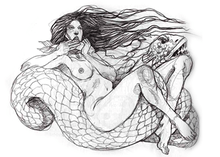Revelations of the Dark Mother
Revelations of the Dark Mother, subtitled Seeds from the Twilight Garden,[1] is an epic poem written by Phil Brucato and Rachelle Udell, illustrated by Rebecca Guay, Vince Locke, and Eric Hotz, and published by White Wolf Publishing in 1998. Based on the tabletop role-playing game Vampire: The Masquerade and the World of Darkness series, the poem centers around Lilith and is her counterpoint to 1993's The Book of Nod, a poem focused on Caine, the first murderer. It is written in the same style as The Book of Nod, with heavy use of illustrations, and with a "vampire scholar" framing.
 Cover art | |
| Author |
|
|---|---|
| Illustrator | |
| Country | United States |
| Language | English |
| Series | World of Darkness |
| Genre | Epic poem |
| Publisher | White Wolf Publishing |
Publication date | 1998 |
| Pages | 123 |
| ISBN | 1-56504-237-9 |
| Preceded by | The Book of Nod |
The poem was well received for its portrayal of Lilith and her inclusion in the vampire mythology, for adding depth to the Vampire: The Masquerade world, and for the art and design, particularly Guay's artwork of Lilith.
Summary
Revelations of the Dark Mother is an epic poem[2] based on the tabletop role-playing game Vampire: The Masquerade and the World of Darkness series,[3] providing background information on the character Lilith.[4] It is written in the style of the earlier publication The Book of Nod (1993),[3][5] and is Lilith's counterpoint to The Book of Nod's story of the biblical first murderer Caine, who in the fiction of Vampire: The Masquerade is re-imagined as being cursed with vampirism and as the progenitor of all vampires.[2][3] Like The Book of Nod, it has a "vampire scholar" framing device; it makes heavy use of illustration, and has the same verse structure. The cover art, too, mirrors The Book of Nod's, featuring a silver pictogram on a black background symbolizing a progenitor – Lilith – surrounded by its offspring.[3]
The book, which presents itself as a heretical document existing within the Vampire: The Masquerade fiction, written and compiled by the vampire scholar Rachel Dolium, begins with a foreword by Dolium,[3][6] describing her research for the book, Lilith and her lessons of growing through pain, and the Bahari cultists who follow her.[6] Following this are three chapters:[5]
- "First Circle: The Book of the Serpent" recounts Lilith's creation and her trials:[6] Jehovah creates Adam, the first man, and Lilith, the first woman, from True Earth in the garden of Eden. Lilith eats the fruit of the trees of life and knowledge, and learns to hunt; Adam is angered and distances himself from her, and, in his loneliness, mates with beasts. Jehovah finds this detestable, and tells him to mate with Lilith instead; she refuses, finding his actions repulsive. After he tries to rape her, she is lifted to heaven, becoming Jehovah's lover. Later, Jehovah jealously banishes Lilith, not wanting her to be his equal. Wandering the desert, she meets Lucifer and becomes his lover, and he makes her the ruler of the night. Jehovah begins creating another woman of True Earth, but Adam is horrified from seeing her innards, so Jehovah destroys her and creates Eve, the second woman, from Adam's rib, making her lesser. Wanting to make her own garden, Lilith returns to Eden and meets Lucifer, who is guarding the entrance, and tricks him into letting her in. Disguised as a Great Serpent, she steals seeds and, feeling sorry for Eve, convinces her to eat of the fruit and has sex with her. In turn, Eve shares the fruit with Adam. Angered, Jehovah exiles Adam, Eve, Lilith and Lucifer; Lilith brings Lucifer with her, and they make a new garden and have six children.[2][7]
- "Second Circle: The Book of the Owl" is a retelling of some of the events from "First Circle" from Lilith's perspective, and recounts her meeting with Caine, taking him in to her and Lucifer's garden, and teaching him to grow through suffering. Lilith creates another garden, D'hainu, which grows until Caine returns with his vampiric descendants, who burn the garden and slaughter Lilith's and Lucifer's children; Lilith curses Caine and his descendants, except for Toreador and Nosferatu, who had pitied the dead.[8]
- "Third Circle: The Book of the Dragon" recounts Lilith's declaration of a long night of suffering, particularly upon Caine and his descendants, that will finally end with her return during the end of the world.[6][9]
Production and release

Revelations of the Dark Mother was written by Phil Brucato and Rachelle Udell, and was illustrated by three artists: Rebecca Guay, Vince Locke, and Eric Hotz. Guay drew the main illustrations for Lilith's story, using pencil or charcoal, and Locke illustrated the vampire scholar Rachel Dolium in the foreword. No works in the book are signed by Hotz; Don Bassingthwaite, writing for SF Site, guessed that Hotz was responsible for the pictograms.[3] The poem was published by White Wolf Publishing in late 1998 in the form of a 123-page booklet.[3][4]
Reception
Yvonne J. Milspaw and Wesley K. Evans, in their article "Variations on Vampires" in Western Folklore, called the poem "powerful", and found the addition of Lilith, a feminine divine, to the Book of Genesis-based vampire mythology "elegant" and adding depth, with Lilith and Caine used as opposites to Adam and Abel across multiple axes: Lilith the wife versus Adam the husband, and Caine and Abel the brothers; and Lilith the stepmother versus Caine the stepson, and Adam the father versus Abel the son. They saw them as analogies for opposing life styles, and as adding oppositions of magical-versus-mundane, darkness-versus-light, and wilderness-versus-garden.[2] Bassingthwaite called Lilith's story fresh, mature and sophisticated, and appreciated the voice given to her, describing her portrayal as that of a "strong, independent, magickal woman".[3] Backstab called the book graphic, poetic, and inspired, giving Vampire: The Masquerade more depth, and thought that readers interested in alternate views of the Vampire: The Masquerade world and in interpreting and discovering what is revealed in the poem would love it.[5]

Bassingthwaite praised the book's design and layout, comparing it favorably to The Book of Nod: he found Guay's artwork beautiful, and conveying a Lilith that is "variously powerful, afflicted, sorrowful, loving, and avenging"; Locke's artwork successfully setting off the foreword with its portrayal of Dolium; and the pictograms interesting and organic.[3] Backstab, too, liked Guay's illustration work, calling it "superb".[5]
Discussing Revelations of the Dark Mother in the context of a supplement to the Vampire: The Masquerade tabletop game, French magazine Casus Belli said that it, like The Book of Nod, would be of interest to those who find the game's occult-esoteric background fascinating, and appreciated its unexpected comedic elements, but thought that the way it only targets big fans of World of Darkness, and the lack of a French translation, could make it hard to use when playing Vampire: The Masquerade.[4][10] Bassingthwaite thought that the poem would be most useful in a game dealing with themes of mysticism, conspiracies and end-times, with the section "The Rising Tides"'s prophecy of Lilith's return; he also saw it as useful for World of Darkness games outside of Vampire: The Masquerade, particularly Mage: The Ascension, Vampire: The Dark Ages, and dark games of Changeling: The Dreaming.[3]
References
- Brucato, Phil; Udell, Rachell (1998). Revelations of the Dark Mother. White Wolf Publishing. p. 2. ISBN 1-56504-237-9.
- Milspaw, Yvonne J.; Evans, Wesley K. (2010). "Variations on Vampires: Live Action Role Playing, Fantasy and the Revival of Traditional Beliefs". Western Folklore. Western States Folklore Society. 69 (2): 211–250. JSTOR 27896342.
- Bassingthwaite, Don (1999). "Revelations of the Dark Mother". SF Site. Archived from the original on 2016-04-12. Retrieved 2020-04-04.
- "White Wolf". Casus Belli (in French). No. 117. Excelsior Publications. December 1998. p. 15.
- Poste, Timbre (March–April 1999). "Revelations of the Dark Mother". Backstab (in French). No. 14. FC Publications. pp. 42–44.
- Brucato, Phil; Udell, Rachell (1998). "Preface: Coiled by the Roots". Revelations of the Dark Mother. White Wolf Publishing. pp. 4–27. ISBN 1-56504-237-9.
- Brucato, Phil; Udell, Rachell (1998). "First Circle: The Book of the Serpent". Revelations of the Dark Mother. White Wolf Publishing. pp. 28–65. ISBN 1-56504-237-9.
- Brucato, Phil; Udell, Rachell (1998). "Second Circle: The Book of the Owl". Revelations of the Dark Mother. White Wolf Publishing. pp. 66–103. ISBN 1-56504-237-9.
- Brucato, Phil; Udell, Rachell (1998). "Third Circle: The Book of the Dragon". Revelations of the Dark Mother. White Wolf Publishing. pp. 104–123. ISBN 1-56504-237-9.
- "White Wolf". Casus Belli (in French). No. 118. Excelsior Publications. February–March 1999. p. 80.